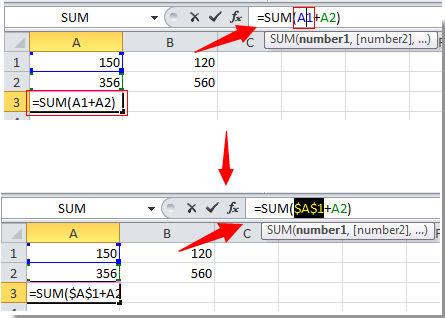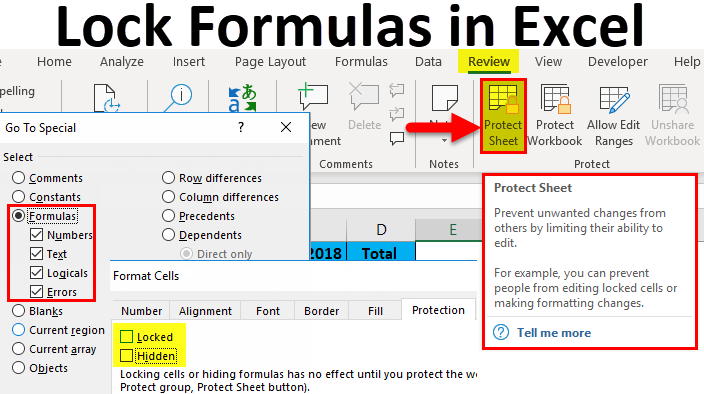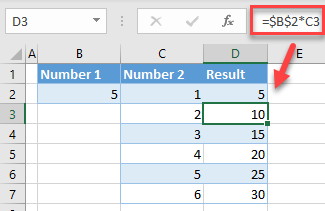To fix a cell in an Excel formula, use the $ symbol before the column letter or row number. This locks the reference.
Excel users often need to fix cell references to prevent them from changing when copying or dragging formulas. Understanding how to anchor cells is crucial for accurate calculations and data analysis. By following simple steps and mastering this feature, users can efficiently manage and manipulate data within their Excel spreadsheets.
Let’s explore how to fix cells in Excel formulas to enhance productivity and streamline data processing tasks. Unlock the potential of Excel functions by learning how to fix cell references effectively and effortlessly.

Credit: www.extendoffice.com
Benefits Of Fixing Cells In Excel Formulas
When working with complex Excel spreadsheets, fixing cells in formulas can provide several benefits. These benefits include increased efficiency and reduced errors, ultimately leading to more accurate and reliable data analysis. Understanding the advantages of fixing cells in Excel formulas can significantly improve your productivity and the quality of your work. In this blog post, we’ll explore the specific benefits of fixing cells in Excel formulas and how it can positively impact your spreadsheet workflow.
Increased Efficiency
By fixing cells in Excel formulas, you can streamline your spreadsheet operations and optimize your workflow. Rather than manually adjusting cell references in each individual formula, fixing cells allows for seamless replication of formulas across multiple cells. This eliminates the need for manual modifications, saving time and effort in the process.
Reduced Errors
Fixing cells in Excel formulas helps minimize the risk of errors that can occur when copying and pasting formulas across cells. With fixed cell references, you can ensure that the correct data points are consistently used in calculations, reducing the likelihood of inaccuracies or miscalculations within your spreadsheets.
How To Fix A Cell In An Excel Formula
In Excel, fixing a cell in a formula allows you to keep a specific cell reference constant, making it easier to copy the formula without changing the reference. There are two common methods to fix a cell in an Excel formula: using the $ symbol and utilizing the F4 key.
Using The $ Symbol
The $ symbol is used in Excel to fix either the column or row reference in a formula. Placing $ before the column letter or row number locks the reference when the formula is copied to other cells.
Using The F4 Key
Pressing F4 while editing a formula in Excel toggles between different types of cell references. It cycles through fixing either the row only, column only, both row and column, or removing the fixed reference.
When To Fix Cells In Excel Formulas
In Excel, fixing cells in formulas is crucial for ensuring accurate calculations and consistent results. Knowing when to fix cells can prevent errors and streamline your workflow.
Referencing A Constant Value
When referencing a constant value in Excel formulas, such as tax rates or conversion factors, fix the cell reference with an absolute reference using the dollar ($) sign.
Referencing A Header Cell
When referencing a header cell that contains variable data, like sales figures or product prices, use a mixed reference by fixing either the row or column reference as needed.
Common Mistakes When Fixing Cells In Excel Formulas
When working with Excel formulas, fixing cells is a crucial aspect that can often lead to mistakes if not executed properly. Understanding the common pitfalls in fixing cells within Excel formulas is essential for ensuring accuracy and reliability in your spreadsheet calculations. Let’s take a closer look at some of the most frequent errors that occur when fixing cells in Excel formulas.
Forgetting To Fix The Row Or Column
When using cell references in Excel formulas, it’s easy to forget to fix the row or column when copying the formula to other cells. This can result in inaccurate calculations as the formula will adjust the cell references relative to their new location. To avoid this, always use absolute references by adding a dollar sign before the row number, column letter, or both. For instance, $A$1 will remain fixed when copied to other cells, ensuring the correct reference is maintained.
Fixing The Wrong Cells
An all too common mistake when fixing cells in Excel formulas is selecting the wrong cells for reference. This can lead to miscalculations and errors in your spreadsheet. To prevent this, double-check the cell references within your formulas to ensure that they accurately reflect the data you intend to use. Using a clear naming convention for your cells can also help to avoid any confusion and ensure correct referencing in your formulas.
Tips And Tricks For Fixing Cells In Excel Formulas
Get expert tips and tricks for fixing cells in Excel formulas. Learn how to accurately fix cells within formulas to avoid errors and improve efficiency in your Excel spreadsheets.
If you work with Excel on a regular basis, you’re probably familiar with the frustration of having your formulas break when you insert or delete rows or columns. Fixing cells in Excel formulas is an essential skill that can help you save time and avoid errors. In this article, we’ll explore two powerful techniques for ensuring that your formulas always reference the right cells: using relative references and using named ranges. Let’s dive in!
Using Relative References
When you create a formula in Excel, it typically uses relative references by default. This means that when you copy the formula to another cell, it adjusts the cell references based on its new location. For example, if you have a formula in cell B10 that references cell A1, when you copy the formula to cell B11, it will automatically update the reference to cell A2. This can be really handy when you need to calculate values for multiple rows or columns.
However, there may be times when you want to fix a specific cell reference in a formula, regardless of its location. To do this, you can use absolute references. An absolute reference is denoted by a dollar sign ($) before the column letter and/or row number. For example, if you have a formula that needs to always reference cell A1, you can use the absolute reference $A$1. When you copy this formula to another cell, the reference to A1 will always remain the same, no matter where you paste it.
In addition to absolute references, Excel also allows you to use mixed references, where only the column or row reference is fixed. For example, if you want to fix the column but not the row, you can use the reference $A1. Similarly, if you want to fix the row but not the column, you can use the reference A$1.
Using Named Ranges
Another way to fix cells in Excel formulas is by using named ranges. Instead of using cell references like A1 or B10, you can assign a meaningful name to a range of cells and use that name in your formulas. This can make your formulas easier to read and understand, especially when working with large worksheets.
To create a named range, simply select the cells you want to name, then go to the Formulas tab and click on the Define Name button in the Defined Names group. Give your range a descriptive name, such as “Sales” or “Expenses”, and click OK. You can now use this name in your formulas instead of the cell references.
Using named ranges not only simplifies your formulas but also makes them more resilient to changes in your worksheet. If you insert or delete rows or columns that affect the range, Excel will automatically adjust the named range accordingly. This can save you a lot of time and effort in maintaining and updating your formulas.
Summary
- Fixing cells in Excel formulas is crucial to ensure accuracy and efficiency.
- Using relative references allows formulas to adjust automatically when copied to different cells.
- Absolute references can be used to fix specific cell references in formulas.
- Mixed references provide flexibility in fixing either the column or row reference.
- Named ranges offer a convenient way to use descriptive names instead of cell references in formulas.
- Named ranges are more resilient to changes in the worksheet and make formulas easier to maintain.
By using these tips and tricks, you can ensure that your Excel formulas always reference the correct cells, saving you time and preventing errors. Whether you’re working with simple calculations or complex financial models, mastering the art of fixing cells in Excel formulas is an essential skill for any user.

Credit: yodalearning.com

Credit: www.educba.com
Frequently Asked Questions On Excel Fix Cell In Formula
How Do You Make A Cell Fixed In Excel Formula?
To make a cell fixed in an Excel formula, use the dollar sign ($) before the column letter and row number of the cell reference. For example, to fix cell A1, use $A$1 in the formula.
How Do You Lock A Cell In A Formula In Excel?
To lock a cell in a formula in Excel, simply add a dollar sign before the column letter and row number. Example: $A$1.
How Do You Fix A Field In A Formula In Excel?
To fix a field in an Excel formula, simply add a dollar sign before the column and/or row reference. This locks the cell and prevents it from changing when copying the formula to other cells.
How Do You Fix A Value In A Formula In Excel?
To fix a value in a formula in Excel, simply add a dollar sign before the column letter and row number (e. g. $A$1) to keep the value constant when copying the formula.
Conclusion
Mastering the art of fixing cells in formulas is essential for effective data analysis and manipulation in Excel. With the knowledge and application of absolute and relative cell references, you can significantly improve your efficiency and accuracy in spreadsheet tasks.
Embracing these techniques will pave the way for more seamless data management and manipulation in Excel.


